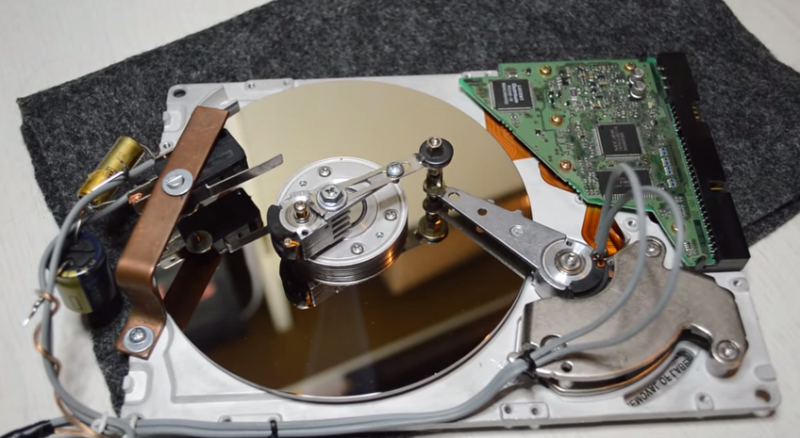Just about all of us have a few old hard drives in our junk box. There are a myriad of projects out there to put them to work in new and interesting ways. One of those ways is to turn your hard drive into a solenoid motor of sorts. (YouTube link) This isn’t a new hack, videos of it have been kicking around the internet for years. [black1985vette] gives a pretty good explanation of how he’s done it. He used a piece of brass as a connecting rod between the drive head and a pin mounted off-center to the platter hub. One of the platter mounting screws provides the perfect place to set the pin. A bent safety-pin rubs the center of the hub, which is partially insulated with tape. When the pin contacts the hub, the drive head is energized, pushing the whole assembly around. The mass of the platters acts as a flywheel, carrying the motor the rest of the way around.
[Pulverrostmannen] performed a similar mod, though he used a micro switch to time the drive head. Rather than a brass connecting rod, [Pulverrostmannen] used a spare head. With a simple transistor circuit acting as a speed control, his hard drive motor revved up to around 1560 RPM, which is pretty respectable for a bunch of junk parts.
So next time you’re stuck in on cold rainy weekend, pull out some of those old drives and get hacking! Click past the break to several of these projects in action.
















This is a cool hack. They are fun to watch and listen to.
Yes, it is impractical. If your goal is just to spin then just use the main motor.
But as the description in the video aptly says:
“When engineers get bored”
My grandfather built something similar for a cousin of mine.
He used the Flywheel from a brocken Steam-Engine and replaced the Piston-Assembly with a Electromagnet and a piece of iron. The Switching was done by an eccentric atachment on the flywheel pressing down on a strap of Copper.
The whole thing ran of a 4,5V “Flachbatterie” (3 Batteries slightly larger than AA in a platic housing) and worked quite well.
Ever since I saw Sprite_tm’s elabolate hard-drive firmware hack a couple years back (http://hackaday.com/2013/08/02/sprite_tm-ohm2013-talk-hacking-hard-drive-controller-chips/) I’ve been wondering if HDD controller boards could be reflashed as general purpose embedded systems via JTAG. Hmmm
Love the white keyboard in the background.
back in about 1992 I coined my version of the first one in that first video
‘electromagnetic piston inducing engine’ :)
This is a sweet hack, I’ll see if I can make it a project for the robotics program I do, maybe we can use up the tubs of old hard drives!
need variable “ignition” timing :)
If you wanted a slightly less mechanical method of doing this, you could wire up the switch to one of the motor coils instead, and pulse that. Since neither method’s really a very practical way of doing things, though, and is primerily for the spectacle, you might as well go for the crank arrangement.
If you are already using a HDD and want to keep with the simple single-coil idea, you could use one of the coils in the platter motor and an optical pickup reading patterns on the platter to sync the pulsing, no balance issues/noise and could probably get going pretty fast! This helps avoid fabrication of mechanical linkages, but adds more control electronics.
Adjustments could be made by using a dry erase and tweaking the ‘on’ regions, maybe even make different profiles across the disk and sweep the optical pickup to adjust which track it sees.
After the apocalypse, all the Worlds’ data will be accessed this way…
By cockroaches that will scratch their heads and wonder what the fuss was about.
it is COOL …
Who’da thunk… I dig it.